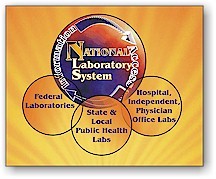|
|
 |
 |
 |
 |

|
Slide Presentation:
PDF (600K), PowerPoint
(1.6M)
Related Article:
"A Nationwide Focus on Public Heath" - Clinical Laboratory
News Vol. 26 No. 9
Contacts
|
 |
Program
Overview
America’s health is increasingly at risk from emerging infectious
diseases, foodborne illnesses, environmental exposures and the potential
for chemical and biological terrorism. These increased risks are
associated with a variety of factors, including increased global travel,
widespread access to imported foods, the role of environmental factors in
chronic disease and the rise of domestic and international terrorism.
The Division of
Laboratory Systems (DLS) firmly believes that development of a nation-wide laboratory
system which provides the communication, coordination and testing capacity
required to effectively detect and report outbreaks and exposures is
crucial to the future health and safety of our communities.
There have been a
number of reports that have underscored the need for development of such
a system:
- Emerging Infectious
Diseases: Consensus on Needed Laboratory Capacity Could Strengthen
Surveillance
Text, PDF
(Feb. 1999 - General Accounting Office report)
- Notifiable Disease
Reporting by Out-of-State Laboratories, Implications for Managed Care
and Options for Reform (Jan. 1999 - George Washington University)
- Public
Health Laboratories and Health System Change (Oct.1997 - Lewin
Group Report)
Recent federal initiatives addressing issues such as
bioterrorism, food safety and emerging infectious diseases have
identified similar needs and may provide the funding required for the long
term success of a nation-wide laboratory system.
|
 |
Demonstration
Project Updates:
|
 |
NLS Activities in Focal Area C
of BT Supplemental Funding
-
Slides from Dr. Robert Martin's presentation to the State Public Health
Laboratory Directors at the regional workshops held in Atlanta,
Boston, Denver and San Francisco (March 2002). - PowerPoint,
PDF
- Emergency Supplement Guidance Tool: Position Description Template
for a State Laboratory Training Coordinator - MS
Word, PDF
|
 |
2003
Goals
- Continue to support the six NLS demonstration projects and expand to
additional states.
- Continue support for the Clinical Laboratory Initiative as the
director, Jon Counts, focuses on: 1) factors that affect why labs select
methodologies, technologies and testing policies/protocols in clinical
microbiology, 2) factors to consider in determining levels of service in
small hospital labs, 3) assessment of perceptions of clinical
microbiologists and clinicians of the quality of testing performed in
primary referral and reference labs, and, 4) other factors that affect
implementation of clinical microbiology testing practices, including
point-of-care testing.
- Foster development of the National Center for Public Health
Laboratory Leadership
- Continue regional meetings of state laboratory directors and
laboratory liaisons to address issues of national and regional concern.
- Expand the National Laboratory Database (NLD) to include
approximately 1,000 VA labs and the estimated 10,000 public health
laboratories currently registered under multi-site certificates of other
public health laboratories.
- Expand the granularity of information in the NLD by working with
State Surveyors and/or proficiency testing programs to increase
information on testing capabilities.
- Collaborate with proficiency testing providers in the private sector
to update the list of approximately 4,400 clinical laboratories with
expected capabilities of conducting Level A bioterrorism testing and
redistribute the list to state public health laboratories.
- Continue development of a geographical information systems (GIS)
program for public health officials to allow identification of clinical
laboratories and their testing capabilities within a given location.
- Continue to foster stronger ties within CDC programs and broaden
awareness among professional organizations, and state and local public
health agencies.
- Broaden participation in the NLS consultants group to include
representatives from more professional laboratory organizations and
other stakeholder groups.
|
 |
2002
Accomplishments
- Continued funding of the NLS demonstration in the Northwest,
Washington Clinical Laboratory Initiative: 1) built on previous
work that showed microbiology laboratories lacked understanding of, and
adherence to guidelines for antimicrobial resistance testing, 2) targeted
gaps in practice based on availability of educational media (PCs,
Internet, satellite downlinks, etc.), and, 3) broadcasted a series on
antimicrobial resistance testing to 16 states in the Northwest Center,
reaching 161 sites and 713 individuals. This work continues to leverage
CDC and PHPPO assets including expertise in antimicrobial susceptibility
testing at NCID, the NLTN, and the Seattle Center for Public Health
Preparedness.
- Expanded the NLS to include two new states, Massachusetts and
Wisconsin, which have shown outstanding leadership in connecting with the
private laboratory community.
- Set up internal systems to deploy access and training for use of the
National Laboratory Database, which is used by approximately 250 users in
at least 46 states. The number of users is increasing among State users
and other Federal partners: both HRSA and the VA Administration recently
joined the users of the database.
- Launched the National Center for Public Health Laboratory Leadership.
- Conducted regional meetings of state laboratory directors and
laboratory liaisons in the Northwest and Midwest.
|
|
|
|
This page last reviewed: 7/12/2004
|
|